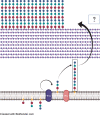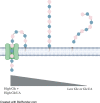Sugar-Coated Killer: Serotype 3 Pneumococcal Disease
- PMID: 33425786
- PMCID: PMC7786310
- DOI: 10.3389/fcimb.2020.613287
Sugar-Coated Killer: Serotype 3 Pneumococcal Disease
Abstract
Capsular polysaccharide (CPS), which surrounds the bacteria, is one of the most significant and multifaceted contributors to Streptococcus pneumoniae virulence. Capsule prevents entrapment in mucus during colonization, traps water to protect against desiccation, can serve as an energy reserve, and protects the bacterium against complement-mediated opsonization and immune cell phagocytosis. To date, 100 biochemically and serologically distinct capsule types have been identified for S. pneumoniae; 20 to 30 of which have well-defined propensity to cause opportunistic human infection. Among these, serotype 3 is perhaps the most problematic as serotype 3 infections are characterized as having severe clinical manifestations including empyema, bacteremia, cardiotoxicity, and meningitis; consequently, with a fatality rate of 30%-47%. Moreover, serotype 3 resists antibody-mediated clearance despite its inclusion in the current 13-valent conjugate vaccine formulation. This review covers the role of capsule in pneumococcal pathogenesis and the importance of serotype 3 on human disease. We discuss how serotype 3 capsule synthesis and presentation on the bacterial surface is distinct from other serotypes, the biochemical and physiological properties of this capsule type that facilitate its ability to cause disease, and why existing vaccines are unable to confer protection. We conclude with discussion of the clonal properties of serotype 3 and how these have changed since introduction of the 13-valent vaccine in 2000.
Keywords: Streptococcus pneumoniae; capsule production; invasive pneumococcal disease; serotype 3; synthase-dependent pathway; vaccine escape; wzy-dependent pathway.
Copyright © 2020 Luck, Tettelin and Orihuela.
Conflict of interest statement
The authors declare that the research was conducted in the absence of any commercial or financial relationships that could be construed as a potential conflict of interest.
Figures




References
-
- Alonso De Velasco E., Dekker B. A., Verheul A. F., Feldman R. G., Verhoef J., Snippe H. (1995). Anti-polysaccharide immunoglobulin isotype levels and opsonic activity of antisera: relationships with protection against Streptococcus pneumoniae infection in mice. J. Infect. Dis. 172, 562–565. 10.1093/infdis/172.2.562 - DOI - PubMed
Publication types
MeSH terms
Substances
Grants and funding
LinkOut - more resources
Full Text Sources
Medical

